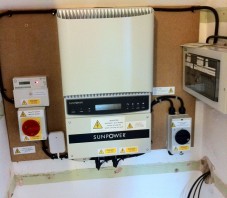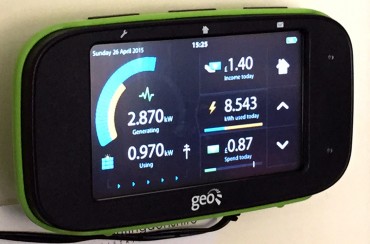Solar panels — a year on
We wanted to install solar panels for years — in my case decades, since I was involved in the “Alternative Technology” magazine Undercurrents in the 1970s. In the past, the idea of a solar PV system has just been too expensive (friends down the street paid £15,000 for their system just a few years ago), but we’d been watching prices fall until, by the middle of 2014, it looked as if prices had fallen to an affordable level.
We interviewed four companies and it quickly became evident that the height of the roof wouldn’t allow the conventional 16 panels in two rows “portrait” style that is common for a 4kWp system – they would have to be mounted too close to the top and bottom of the roof (you need 500mm clearance all round — otherwise you can risk less stability in high winds). We could, however, manage two rows of six, “landscape” style. The companies we talked to varied in the amount of work they did specifying the installation, and I regard actually getting up into the loft and taking real measurements as an indicator that the installer is worth considering.
The limitation of 12 panels immediately made the choice a relatively simple one. We needed high efficiency panels, and the SunPower design, it was easy to see from the data sheets, was not only superior in engineering terms (they are not only more efficient, but they have a sturdy backplane system with no buses running down the front of the panels, making them less prone to damage; and if a cell does get damaged, it doesn’t take the whole row out or worse), it also enabled us to install a system that would deliver a little under 4kWp from just 12 panels. Perfect! Two companies out of the four had offered us SunPower panels. One was an enormous supplier in the Midlands that in fact I would recommend for anyone looking for a commercial installation, but they were rather expensive — significantly more than any of the others.
 We selected our supplier, Solarworks of Lavenham in Suffolk, who have been installing renewable systems since 1983. Just a couple of weeks later the scaffolding arrived and while it was set up, Solarworks fitted the inverter – an ABB “Uno” single-phase model – and associated switchgear in the closet under the stairs (see picture left — note the black rotary switch bottom right, which is a proper DC isolator on the input path from the panels — which were still to be hooked up when this picture was taken). Above the AC isolator on the left is the Generation Meter. The next day, they installed the mounting rails on the roof. Because our panels were to be mounted horizontally, the rails were vertical and each of the 12 was attached to a different rafter, giving exceptional strength.
We selected our supplier, Solarworks of Lavenham in Suffolk, who have been installing renewable systems since 1983. Just a couple of weeks later the scaffolding arrived and while it was set up, Solarworks fitted the inverter – an ABB “Uno” single-phase model – and associated switchgear in the closet under the stairs (see picture left — note the black rotary switch bottom right, which is a proper DC isolator on the input path from the panels — which were still to be hooked up when this picture was taken). Above the AC isolator on the left is the Generation Meter. The next day, they installed the mounting rails on the roof. Because our panels were to be mounted horizontally, the rails were vertical and each of the 12 was attached to a different rafter, giving exceptional strength.
The following day, the panels went up, and as soon as they were connected, by mid-late afternoon – in two strings of six each – the inverter was indicating that we were generating 3.6kW of electricity. And the story has continued, with the system regularly generating more kWh than we use in an average day. This year, we saw the output exceed 3.7kW as early as March! (Which surprised me in fact, as you would have thought there would be losses between the 3.9kWp nominal panels and the inverter.) The installation, just after completion, is shown above.
We’re very pleased with the results and would recommend both SunPower panels and Solarworks as an installer.
We subsequently had our old Ferranti rotating-disc import meter replaced so that it wouldn’t go backwards. The latter sounds like a cool thing but actually isn’t, because you are already being paid for the electricity you are exporting and the electricity supplier can claim it back retrospectively; plus I wanted a modern meter with an LED indicator on to which I could strap a counter for metering.
 The metering system I installed came from Geo (Green Energy Options) in Cambridge. It measures the power output from the panels (via the flashing light on the Generation Meter), the amount imported from the Grid (via the flashing light on the new Import Meter), and the raw current flow in or out of the building (from a clip around the main power input cable), and calculates a range of data from those raw inputs. Very nice. On the display shown here, the blue curve represents the output from the panels (quite good for an overcast day, I think) and the orange is the amount of energy we’re using – these values are shown numerically in the centre left of the display. The little blue arrows at the bottom show we are exporting electricity, and the little green waveform above the wattage displays indicates that we have enough “free” power to run a major appliance such as a washing machine or dishwasher, without effectively paying for it; and on the right is our electricity usage so far today and how much our income from generation and our spend have been. The system is connected to the Internet so you can remotely monitor system performance via the Web.
The metering system I installed came from Geo (Green Energy Options) in Cambridge. It measures the power output from the panels (via the flashing light on the Generation Meter), the amount imported from the Grid (via the flashing light on the new Import Meter), and the raw current flow in or out of the building (from a clip around the main power input cable), and calculates a range of data from those raw inputs. Very nice. On the display shown here, the blue curve represents the output from the panels (quite good for an overcast day, I think) and the orange is the amount of energy we’re using – these values are shown numerically in the centre left of the display. The little blue arrows at the bottom show we are exporting electricity, and the little green waveform above the wattage displays indicates that we have enough “free” power to run a major appliance such as a washing machine or dishwasher, without effectively paying for it; and on the right is our electricity usage so far today and how much our income from generation and our spend have been. The system is connected to the Internet so you can remotely monitor system performance via the Web.
Our electricity supplier is Ecotricity, and setting up for their Microtricity scheme to receive the Feed-in Tariff (FiT) was simple to do. Now they are often banking with me, and have had to revise my electricity payments down significantly as a result.
Having had the panels installed for almost a year, it looks as if we are running somewhat ahead of schedule as far as these panels paying for themselves is concerned.
April 25, 2015 Comments Off on Solar panels — a year on

